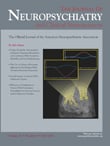To the Editor: Huntington’s disease is a progressive degenerative neuropsychiatric condition that is transmitted via autosomal dominant inheritance. Affected individuals have CAG trinucleotide repeats within the
Huntingtin gene on chromosome 4p16.3. Besides the classic chorea, neuropsychiatric symptoms in Huntington’s disease include dysphoria, agitation, irritability, impulsivity, aggressiveness, disinhibition, and cognitive impairment.
1 Impulsivity and aggressiveness in particular are associated with increased rates of behavioral difficulties and hospitalization.
2 Behavioral dyscontrol in patients with Huntington’s disease has been a subject of much interest and debate, especially as it may relate to criminality and culpability. In a case-controlled study based on the Danish Huntington’s disease registry, Jensen et al.
3 found an increased prevalence of criminal offenses in males carrying the gene for Huntington’s disease, compared to relatives (RR 2.8) and control subjects (RR 2.3). The offenses included drunken driving, traffic offenses, theft, assaults, molestation, threats, and use of physical violence. There were no significant differences between female Huntington’s disease patients and relatives and control subjects. These comparisons were done regardless of whether the subjects had been diagnosed with Huntington’s disease at the time of the offenses.
3Case Report
Mr. A is a 48-year-old man, brought in by police for psychiatric assessment after allegedly slapping, kicking, and punching his wife after a minor altercation. This was his first encounter with psychiatry. On examination he was alert and responsive but oriented only to person. He denied feeling depressed, currently or in the past, and denied manic or psychotic symptoms or use of substances. His Mini-Mental Status Examination score was 12/30 and he had poor insight into his illness. While he stated that he should not have struck his wife, he did not have a deeper appreciation of the nature and quality of his actions at the time of the alleged offense.
Mr. A had been diagnosed with Huntington’s disease at age 40 when he presented with weakness and chorea. His father had passed away from complications of Huntington’s disease in his mid-40s. Mr. A was found to have 51 CAG repeats on one allele and 21 on the other. His three children declined genetic testing after appropriate counseling. His wife described him as always being quick-tempered and reported that he had started abusing her a few years into their marriage when he was in his late 20s. These were unprovoked and random acts of verbal and physical abuse, which included slapping, punching, and kicking, which gradually increased in frequency. He was similarly abusive to their children, but there were no allegations of sexual abuse. His deterioration has been progressive with overt memory deficits, neglect of self-care, and increased irritability and aggressiveness. Neuropsychiatric testing showed that he had severe cognitive impairment. He was acquitted but found to be a risk to self and others and held in a state mental institution.
Discussion
Psychiatric symptoms may be the first manifestation of Huntington’s disease in 79% of patients.
4 Paulsen et al.
1 reviewed an extensive range of symptoms and found that the prevalence of agitation was 67.3%, irritability 65.4%, and disinhibition 34.6%. These symptoms are the ones most likely to be associated with behavioral dyscontrol.
Only on hindsight may we ascribe some of Mr. A’s past behavioral problems as perhaps prodromal of Huntington’s disease. As far as we know, Mr. A started being verbally and physically abusive in his mid-twenties. However, the extent of his neurological damage then is unknown and unknowable now. Could his longstanding behavioral dyscontrol be attributed to an “ornery” personality or part of the Huntington’s disease spectrum, or a combination of both? The number of CAG repeats is crucial. For affected patients, reduced penetrance refers to those with 36–39 repeats and full penetrance refers to those with greater than 40 repeats.
5 For Mr. A, we would expect an earlier onset, rapid progression, and severe symptoms. Moreover, male transmission has been associated with the anticipation phenomenon. We may infer that his onset of symptoms predated the formal diagnosis by many years.
There is also a strong correlation between the number of repeats and the degree of atrophy in the caudate and putamen.
6 Neuronal loss and gliosis also occur in the frontal cortex, substantia nigra, cerebellum, hippocampus, and hypothalamus. This can account for the diverse symptoms. However, the mechanism whereby the mutated form of the gene product causes toxicity has not been well elucidated.
Along the timeline of genetically deterministic decline that starts insidiously but progresses inexorably, many questions arise. At what point would a patient have to be involuntarily hospitalized to prevent him from hurting himself and others; when would he be found lacking in capacity and adjudicated to be incompetent? When would disease severity become a mitigating circumstance or an insanity defense be invoked?
In the future, researchers may uncover the toxic pathways of the mutated Huntingtin protein and estimate how and when the damage sets in. Forensic and legal experts still have to grapple with the issue of how much damage is “enough” with regard to issues of competency and culpability. Nevertheless, here remains an unfortunate patient, his family, and lessons we can learn and share.
The clinician should be more vigilant toward Huntington’s disease patients with symptoms of irritability, aggressiveness, and disinhibition, as they may be predisposed to behavioral difficulties. Appropriate management would include proactive planning for the future, medication, and possibly placement in a more structured environment. These would be done with empathic support and psychoeducation for the patients and their families. We should also be mindful that the far greater majority of Huntington’s disease patients do not have significant behavioral dyscontrol or criminal records and should not be stigmatized.

